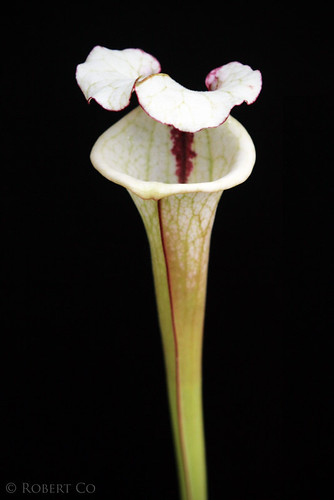Oh Yeah! Packing it up and sharing the Sarracenia love! Recently, a couple folks have asked me about how to pack/send/ship rhizomes out, so I thought I’d share a general kind of how-to on the matter. Keep in mind, this is a very general – the main focus here is just to ensure the plant protected. There are many ways to go about doing this; just try to keep the plant safe and secure and you should be fine.
Now, the plants that I am growing outdoors are just starting to pitcher; but a few of them, such as the one below, have not pitchered yet. I find that this is the easiest time to ship plants as I don’t have to worry about extra packing and handling for the pitchers. If it ever does come to that, I’ll use those triangular tube things (like they use for shipping large prints), or even cut out and create my own from other boxes I have had laying around. Anyway, I like receiving Sarracenia in the rhizome state as I’ll let the plant send up pitchers and acclimate itself in my climate.
I start by removing the plant from the pot, and washing away the medium from the roots. I do this to save on shipping costs (weight), and I find it’s just a cleaner way to handle packing. If the plant is in active growth however, I’ll do my best to keep the core of the root ball in tact to minimize stress, then wrap and ship carefully.

[Ready for packing.]
So now that the rhizome is cleaned up, I use a paper towel and wrap the rhizome and roots. I then dampen the towel a bit to prevent the plant from drying out during shipping and to provide a little moisture for it’s journey. Some people will use sphagnum moss, or ship with some of the potting medium on there. That’s fine too.

[Sarracenia wrap.]
After wrapping it up with the paper towels, I’ll drop it into some sort of plastic bag. If shipping multiple plants and placing it in the same bag, be sure to include a label or some sort of way to identify the plant so that the receiver will know what is what.

[In the bag.]
Next, I just rolled and taped it up. You don’t really have to do this though, it’s just something I did for this shipment. I also labeled the bag with a permanent marker to ID it. Other times I’ve included a tag with the rhizome as a form of identification. Again, do whatever works for you. Notice the bubble wrap in the background – I’ll use that later to pack all this up in the box.

[Taping it up.]
You may use a variety of containers to ship – typically you can get the flat rate priority boxes at the post office. For this particular shipment, I simply re-used and re-purposed another box. I began by opening the box up. I basically just find where the box is joined to the edge, and gently tear it off from there. (See photo below.) This will allow me to turn the box inside out so that none of the other markings / labels from the last shipment would be visible. I don’t want to run the risk of confusing any postal employee, ya know.

[Opening the box up. Re-using and re-purposing.]
Next, I just tape that side back to its corner using packing tape. I will also tape up the bottom, and have a clean looking box ready for re-use.

[Taping it together.]
So, after taping it all together, I proceeded to wrap it up snug and secure with the bubble wrap I had handy. The bubble wrap that I used here was also reused from a prior shipment to me. You can use newspaper, packing peanuts (try to the environmentally friendly kind), or anything else that can cushion the plant and keep it safe. During times of freezing cold, others will use those 48 hour warmer things to keep the plants above freezing. I have no idea what you call em as I’ve never had to ship to an icy location… at least, not yet. I usually just communicate with the receiving party and ship when they tell me that the temperatures are fine.
 [Safe and snug.]
[Safe and snug.]
After it’s safe and snug, I tape it all up, slap a mailing label on it and then send it off. Again, do whatever works for you to ensure the plants are safe and sound. Recycling materials is always great. I’ve re-used materials from the office, such as those air-pack things that are used for the toner cartridges. I’ll keep a few shipping supplies on hand as well that were used for prior shipments and just re-purpose those. No sense in spending additional money or resources for packing, right?
Hope this little packing-up tutorial helps you to spread some of that Sarracenia cheer! Happy shipping! 😉




 [Sarracenia courtii, anthocyanin free clone]
[Sarracenia courtii, anthocyanin free clone]








